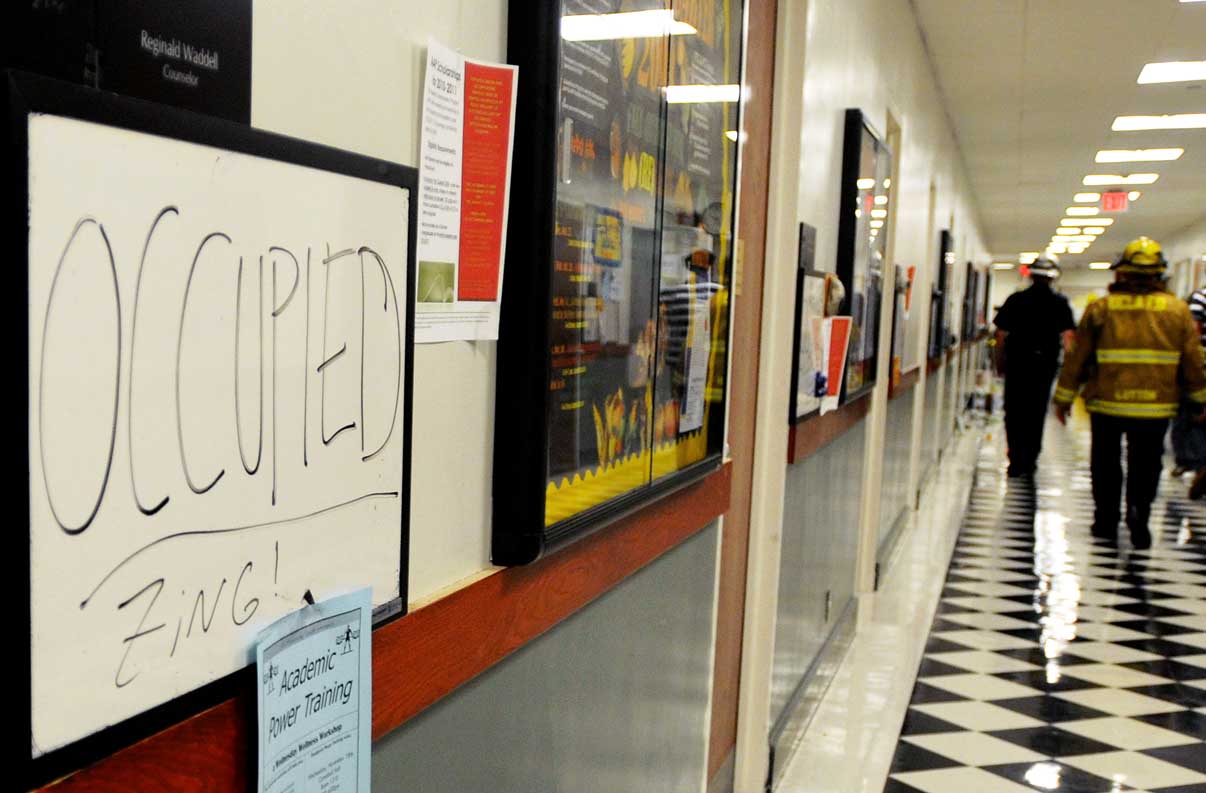CORRECTION: The print version of this story incorrectly stated that two
students were shot in Campbell Hall rather than two Black Panthers, and
that the shootings took place during a Black Panther Party meeting
rather than at a Black Student Union meeting. The print version also said that the students renamed the hall “Carter-Higgins” rather than “Carter-Huggins.”
In a scene reminiscent of the student protests and occupation of Murphy Hall in the 1970s, students from UCLA and other UC campuses, as well as supporters from the Los Angeles area, barricaded themselves inside Campbell Hall early Thursday morning.
About 30 to 50 protesters locked themselves inside the building overnight in response to the UC Board of Regents’ expected approval of a 32 percent student fee increase later that day.
They adorned the outside of the building with protest signs and a banner announcing that they had renamed the building “Carter-Huggins Hall” in honor of the two Black Panthers who were shot and killed in the building during a Black Student Union meeting in 1969.
Speaking through the chained glass doors of Campbell Hall, one student in the building, who identified himself only as a fourth-year UCLA student, described the action as a move to occupy space and stand in solidarity with fellow protesters both at UCLA and at other UC campuses.
“We understand some of the inevitability of the regents’ decision, but also that they were going to make it despite what students or faculty thought,” he said. “That’s why we have decided to take action here today.”
He added that the occupiers would not make demands of the university.
In response to the protestors, university officials issued a statement Thursday morning announcing the closure of the hall and the cancellation of classes and services offered there, including Academic Advancement Program tutoring and counseling.
“I guess I’m not going to be passing (statistics), then,” said Abigail Frisch, a third-year physiological science student who was unable to access tutorial services because of the lock out.
Like others, she expressed her confusion over the selection of Campbell Hall as the site of the sit-in.
“The students are going to be the only ones facing problems with tutoring being shut off,” she said.
Confusion on the inside
The decision to take over Campbell Hall was not the only point of contention in the occupiers’ plan.
According to a student who was inside Campbell Hall during the occupation but declined to be named for privacy concerns, there was confusion and paranoia inside the building, as well as a clear lack of leadership.
“It didn’t seem like a cohesive group,” she said. “They didn’t seem to have a plan or an agenda, and there were some students in there that were not even aware of what AAP is about and what the building really does.”
“That’s a problem.”
The source described the conspirators as mostly non-UCLA students from across California, though by the afternoon, they had been joined by UCLA student protesters who had by then left the protest at Covel.
“The students who showed up afterward were aware of AAP and the services in Campbell Hall and didn’t seem to be in agreement with what was going on inside the building,” the source said.
One of those UCLA students was Alejandra Cruz, a third-year law student who helped organize the protests on the Hill.
“We came out here to have a discussion about the purpose of the occupation,” Cruz said.
She estimated that by her arrival, there were about 50 to 70 individuals in the building and close to as many opinions.
“Once we came, we realized that there was disagreement (about what to do),” she said.
But despite what Cruz characterized as a productive discussion, the general disagreement, combined with rumors about an imminent SWAT-team raid of the building helped convince the occupiers to leave.
At about 6:45 p.m., when UCLA Fire Marshall Dana Johnson arrived on the third floor of Campbell Hall to conduct a check on the safety and welfare of the occupiers, the decision was made on the inside to leave.
“As I walked up (to the building), I heard three toots of an air horn, and then someone said, “˜Everyone out,'” Johnson said.
Within minutes, the occupation that lasted nearly 18 hours ended peacefully.
With the help of two students, Johnson cleared barricades and reopened the building for a police inspection.
While no arrests were made, police would not rule out further action until damages could be fully assessed.
Mixed feelings on the outside
Despite its disruption to academic services and counseling, supporters and sympathizers outside the building characterized the loss as a necessary consequence of the greater goal of fighting program cuts and fee increases.
Throughout the day, these supporters brought food and words of encouragement to the occupiers inside the building, while a larger group found themselves sitting on the building’s steps out front, passing out statements and holding signs of protest.
However, for students not involved in the protests, the takeover appeared to be more of a point of interest rather than a movement to join.
“I was trying to recruit people to come sit on the steps in solidarity, but less than one in 10 seemed interested,” said Ryan Bakhit, a third-year philosophy and neurological science student who spent part of his day on the steps in front of Campbell Hall in support of the student actions.
“(The occupation’s) intention is good, but as far as its productiveness or whether it’s creating any progress, I’m undecided,” Bakhit said.
But to those more involved in the protests of the day, the occupation was a popular move and was interpreted as a show of solidarity for students.
“We had a super successful two days,” Cruz said.
